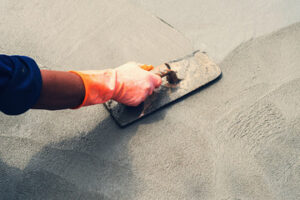Whether you’re dealing with a tilting concrete patio or your front steps have become uneven, there are many ways to fix it. The best way is to use Concrete Leveling, a quick and cost-effective solution for lifting sunken or settled slabs. This product is a cementitious mixture that looks and functions like concrete but flows easier and sets up much faster. It’s pumped or poured into place and then spread evenly with a gauge rake.
 Concrete Leveling Cincinnati is a simple but effective way to repair sunken and cracked driveways, steps, patios, garage floors, and interior slabs. The procedure consists of drilling holes in an uneven concrete slab and pumping in either a cement mixture or polyurethane foam to lift the slab to a level position.
Concrete Leveling Cincinnati is a simple but effective way to repair sunken and cracked driveways, steps, patios, garage floors, and interior slabs. The procedure consists of drilling holes in an uneven concrete slab and pumping in either a cement mixture or polyurethane foam to lift the slab to a level position.
Concrete leveling is a cost-effective alternative to having a new slab poured. It also minimizes future settlement and prevents erosion and washout beneath the concrete slab.
Slabjacking is a concrete leveling process that involves injecting a strong base material, such as cement or polymer resins, under the existing concrete slab(s) to raise them back to their original position. It does not require the slab to be re-broken or discarded, and it is often an environmentally friendly alternative to concrete replacement.
Mudjacking is the traditional method for raising and stabilizing settled concrete slabs. It is the least expensive of all professional concrete repair methods, and regularly comes in at less than half the cost of slab replacement. The process starts with holes that are drilled into the concrete, about half an inch in diameter. A “cocktail” of stable materials, such as sand and gravel, is then injected into the holes. Then, the material is pumped under the concrete slab using a pump.
Concrete is a durable material, but over time it can begin to sag and sink due to soil erosion. This causes issues like uneven sidewalks and patios, which can cause trips or accidents as well as damage to lawn and landscaping. The best way to fix these problems is to raise the sunken slabs back up and stabilize them again. There are a few different ways to do this.
Mudjacking is one method that uses a gravel slurry to fill the voids beneath sunken concrete. This slurry is heavy and requires large machinery to carry and pump it under the concrete. Foam leveling is a much lighter alternative that uses polyurethane foam to lift and level sunken concrete slabs. This process is also safer for the environment and laborers, since the foam is watertight, expands quickly, and doesn’t break down under extreme temperatures.
Slurry Leveling is a cement-based method that combines pulverized limestone, water and Portland cement to create a grout slurry. This slurry is pumped through a series of holes that are around 1″ in diameter.
The slurry first finds weak soils, expanding into them to compress and consolidate the sub-soil and fill any voids below the slab. The expanded foam then exerts pressure on the slab, lifting it up to a level and stable position.
Self-leveling concrete is a polymer-modified cement that quickly fixes uneven floors. It’s a DIY-friendly alternative to regular concrete and can be used on all flooring types.
It is also a great way to repair floors that are structurally unsound. However, it’s important to know that self-leveling concrete does not replace professional construction.
You should always get the product and the surface of the floor inspected prior to applying it. This will help you decide whether it is the right product for your project.
Generally, self-leveling concrete is made of a mixture of Portland cement, polymer plasticizers and other ingredients. It has the strength of concrete but is easier to spread and set up.
Self-leveling concrete comes in a thick liquid consistency that flows around the room and levels itself to create a smooth floor. It can be used as a standalone flooring material or under floor coverings such as LVP, tile, carpet and wood. It can also be decorated with stains, color dyes and saw cuts.